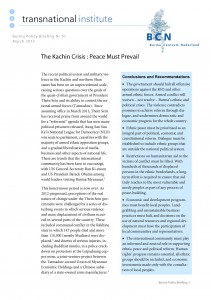The Kachin Crisis: Peace Must Prevail
By Transnational Institute and Burma Centrum Nederland • March 15, 2013 The recent political unrest and military violence in the Kachin and northern Shan states has been on an unprecedented scale, raising serious questions over the goals of the quasi-civilian government of President Thein Sein and its ability to control the national armed forces (Tatmadaw). Since assuming office in March 2011, Thein Sein has received praise from around the world for a “reformist” agenda that has seen many political prisoners released, Aung San Suu Kyi’s National League for Democracy (NLD) win seats to parliament, ceasefires with the majority of armed ethnic opposition groups, and a gradual liberalisation of media, business and other aspects of national life. These are trends that the international community has been keen to encourage, with UN General-Secretary Ban Ki-moon and US President Barack Obama among world leaders visiting Burma/Myanmar.
The recent political unrest and military violence in the Kachin and northern Shan states has been on an unprecedented scale, raising serious questions over the goals of the quasi-civilian government of President Thein Sein and its ability to control the national armed forces (Tatmadaw). Since assuming office in March 2011, Thein Sein has received praise from around the world for a “reformist” agenda that has seen many political prisoners released, Aung San Suu Kyi’s National League for Democracy (NLD) win seats to parliament, ceasefires with the majority of armed ethnic opposition groups, and a gradual liberalisation of media, business and other aspects of national life. These are trends that the international community has been keen to encourage, with UN General-Secretary Ban Ki-moon and US President Barack Obama among world leaders visiting Burma/Myanmar.
This honeymoon period is now over. As 2012 progressed, perceptions of the real nature of change under the Thein Sein government were challenged by a series of disturbing events in which serious violence and mass displacement of civilians occurred in several parts of the country. These included communal conflict in the Rakhine state in which 147 people died and more than 110,000 (mostly Muslims) were displaced, 2 and dozens of serious injuries, including Buddhist monks, in a police crackdown on protestors at the Letpadaung copper mine, a joint-venture project between the Tatmadaw-owned Union of Myanmar Economic Holdings and a Chinese subsidiary of a state-owned arms manufacturer. The most protracted violence, however, took place in northeast Burma during a government offensive against the Kachin Independence Organisation (KIO), an armed ethnic opposition group calling for ethnic rights and autonomy.4 Until the Thein Sein government came to power, the Kachin region had witnessed 17 years of ceasefire. But since fighting resumed in June 2011, thousands of casualties killed or injured – as well as more than 100,000 internally displaced civilians – have been reported.
Download the full briefer here.
Tags: Arakan/Rakhine, Armed Conflict, Burma Centrum Nederland, Kachin, Letpadaung Copper Mine, Peace, Transnational InstituteThis post is in: Crimes Against Humanity, Ethnic Nationalities
Related PostsMyanmar: Free Prisoners of Conscience in Rakhine State End Ongoing Persecution of Rohingya
UN Myanmar Rights Expert: Backtracking on Democratic Space Gains Momentum in Election Year
Myanmar’s Proposed Race and Religion Laws are Discriminatory and should be Scrapped
The FCO’s Human Rights Work 2013
BROUK Welcomes US Senate Resolution on Rohingya









 All posts
All posts